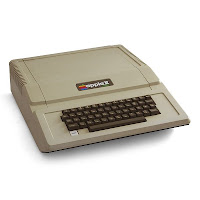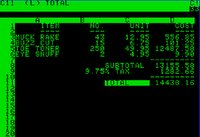
The Apple I started as a hobbyist's project in 1976, and turned into one of the early catalysts of the personal computer revolution. The simple elegance of the WOZ monitor (only 256 bytes!) and readily available parts made this computer accessible to everyone. Unfortunately, today only a few survive.

Below I have links to the original documentation that came with the Apple I, including the hand typed basic manual and owner's manuals. Browsing these, you really get the feel that this was a hobbyist's project, not the beginning of a billion dollar company!
Apple I User's Guide
Apple I BASIC Manual
Apple fritter
Apple I Owner's Club
Replica I
The Replica I is a single board computer that is a functional replica of the groundbreaking Apple I from the 70's. The primary difference is that some of the parts are implemented with modern components. However, it still uses the venerable
6502 and contains the original Woz monitor and Woz's hand assembled BASIC!
.jpg)
My Replica I is using a standard modern PC power supply, a PS/2 style keyboard, and Apple //c 9" monitor. Some of my projects for the Replica I include creating a program loader to allow easy loading/saving programs to an attached PC, and porting one of my favorite old languages, FORTH, to the Replica I/Apple I.
You can buy a
Replica I in kit form or ready built from Vince Briel, a hobbyist and fan of the original Apple I.
FORTH
Forth is a fast, powerful, and portable high level language that was popular in the early days of micro computing because of its ability to easily manipulate hardware details while retaining many benefits of a high level language. It is a "stack oriented" language and thus maps efficiently to an 8-bit microprocessor.

Forth has a small kernel of "words" that are implemented in the native assembler of the target platform. The balance of the language consists of further word definitions made up of "address" references to these kernel words. In this way, only a small part of the assembler listing is dependent on the host platform, making this a very portable language (even in assembler!).
This is a
figFORTH 1.1 port originally distributed by W. F. Ragsdale for the Rockwell AIM65 back in the late seventies. I have taken this listing and made a
port to the Apple I/Replica I, resulting in a powerful programming environment for experimentation or computer control applications. FORTH is still popular today and is found in such diverse applications as embedded controllers and PDA's to NASA applications on the Space Shuttle!
FORTH is compact, only 7 Kbytes for the kernel. While fully functional now on the
POM Apple I emulator, I still need to implement block storage in memory so that programs can be loaded and saved independent of the kernel itself with the cassette interface. You can download the current version below.
Note: There is currently an issue in the Pom1 emulator that results in ASCII $1F being used to represent [space] where the Apple I/Replica I expect $20. This must be changed in the listing and recompiled depending on the platform you chose to run on.
If you want to learn more about FORTH, The best place to start is Leo Brodie's book
Starting FORTH which is conveniently online. Also, if you wish to change my port for the Apple I/Replica I, you will need the
CC65 C Compiler and Macro Assembler/Cross Compiler for the 6502. More enhancements to follow...
Micro Chess
One of the most fun things I have done with my new Replica I was to load and run
Peter Jennings' original
Microchess written in 1976. The excitement of seeing this vintage early program come to life on my just assembled Replica was probably much like early Apple I users back in the 70's would have felt on powering up this landmark program the first time. This program was a wonderful accomplishment for
several thousand bytes of code!


































.jpg)



